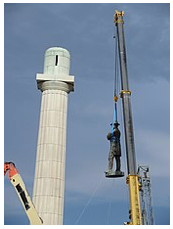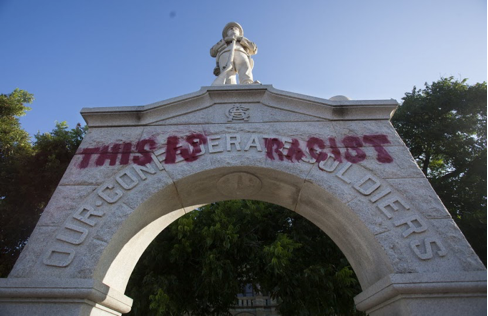CommentsPERSPECTIVE--The American Civil War essentially ended with the retreat by General Lee’s Confederate forces from Richmond, Virginia on April 3, 1865. Lee’s surrender at Appomattox came six days later. The intervening week was characterized by a series of battles and skirmishes along the 90-mile route of retreat, but it was evident that effective resistance against Union forces would not be possible for much longer once the defenses of the capitol were abandoned.
So it seems fitting that today’s modern day conflict – between those who want to preserve memorials dedicated to the leaders and common soldiers of the Confederacy and those who want them removed – could be decided in Richmond.
I’m very familiar with the city and the 14 blocks comprising the Monument Avenue Historic District. Stately Victorian era mansions, where mature trees provide a broad canopy, make it a highly desirable neighborhood.
The statues at the heart of the debate were erected to honor Robert E. Lee, Thomas “Stonewall” Jackson, James E.B. “Jeb” Stuart, Jefferson Davis and Matthew Fontaine Maury. There is also one honoring former tennis great Arthur Ashe, a native of the city who was barred from playing on the city’s public courts while growing up.
With the exception of Maury, these names should be recognizable to many people in the United States and in parts of the developed world. More about Maury later.
The Mayor of Richmond, Levar Stoney, formed a commission of 13 diverse individuals to tackle the controversy. All options will be considered, from the complete removal of the statues, to retaining them, but with context added.
Two members will potentially play very influential roles in the process: Christy Coleman, CEO of the American Civil War Museum and Dr. Edward Ayers, former president of the University of Richmond, my alma mater. Dr. Ayers also chairs the board of the American Civil War Museum.
The new museum they shepherded will offer a comprehensive look at the war; not the Confederate-centric portrayal at the Museum of the Confederacy. The displays there were mainly focused on the battles, leaders and equipment. That’s not to say that there was a lack of interesting content. For example, I recall an excellent exhibition several years ago about the CSS Hunley, the first submarine to ever sink a warship. The tour of the Confederate White House shed light on the day-to-day functions of what was at the time the second largest military power in the world.
It is possible the commission’s recommendation might not go all one way, although, at a minimum, context will be added. That much is already occurring in the city.
I can see a scenario where a couple of statues might remain.
 Resigning from the US military to fight for the south, while treasonable in hindsight, did not amount to an unconscionable act in the minds of those who went down that path. The US Constitution did not address secession. Many people of that era viewed allegiance to their home states as more important. I would say that was generally more prevalent in the south and can be traced to the unfinished business of forming our new nation. Permitting slavery in the Constitution was the devil’s compromise the Founding Fathers made.
Resigning from the US military to fight for the south, while treasonable in hindsight, did not amount to an unconscionable act in the minds of those who went down that path. The US Constitution did not address secession. Many people of that era viewed allegiance to their home states as more important. I would say that was generally more prevalent in the south and can be traced to the unfinished business of forming our new nation. Permitting slavery in the Constitution was the devil’s compromise the Founding Fathers made.
Foreign threats, both military and economic, called for a critical mass of territory, resources and population to counter them, so compromise was a necessary evil to launch the republic quickly. But as the nation matured and grew stronger to the point where such threats diminished, internal differences were reawakened and filled the vacuum.
For Lee and his southern colleagues, choosing sides with their home states was the right thing to do…..and the worst decision any of them ever made. If Lee had stayed with the north, he may have succeeded Lincoln as POTUS.
If the only issue was secession, one could make a strong case for keeping the statues. However, the stench of slavery forever tarnished those who left the Union.
Still, I imagine some members of the commission will consider the importance of transparency in portraying history, however painful it may be.
They may consider other factors as well.
Matthew Fontaine Maury was a commander in the United States Navy at the time Virginia seceded. He chose his state over the Union. He was assigned to port and inland waterway protection.
Maury was openly opposed to slavery and had even developed the framework for a plan to end it, but it never achieved any traction. In a letter to his cousin dated from 1851, “Imagine, waking up some day and finding our country free of slavery!”
He was also a brilliant scientist. Oceanography, meteorology and modern navigation owe much to his research in the years leading up to the war. He was internationally acclaimed for his contributions in those fields and was in charge of the Naval Observatory until he resigned over secession.
Jefferson Davis was not fond of dealing with Maury and sent him off to Europe to arrange for the purchase of naval vessels.
After the war, he found his way into academia, teaching physics at the Virginia Military Institute and later helped form a college which would eventually become Virginia Tech.
I felt it was worthwhile to digress and explore Maury’s career as an example of achievements both before and after the war which may be factors in the commission’s recommendations.
If retaining some or all of the statues with context is where this goes, the content will be as hotly debated as the statues themselves.
Removal of the statues would face legal challenges, notwithstanding the horrific events in Charlottesville, due to Monument Avenue’s designation as a National Historic Landmark. I could see years of litigation which could end up in the US Supreme Court.
I feel for the members of the Commission. They will face a backlash regardless of the outcome – maybe from all sides.
And the Civil War will continue.
(Paul Hatfield is a CPA and serves as President of the Valley Village Homeowners Association. He blogs at Village to Village and contributes to CityWatch. The views presented are those of Mr. Hatfield and his alone and do not represent the opinions of Valley Village Homeowners Association or CityWatch. He can be reached at: [email protected].)
-cw
















